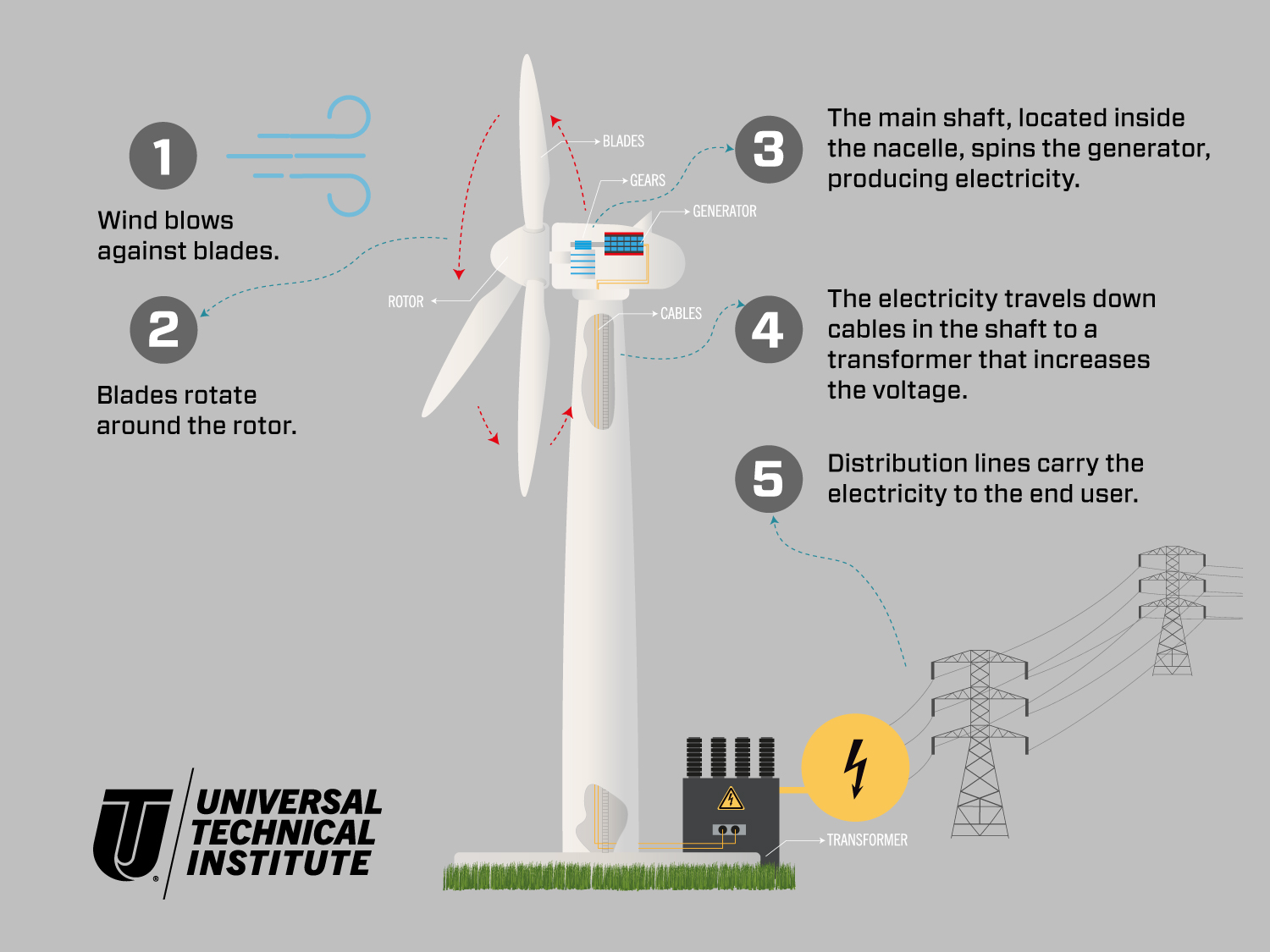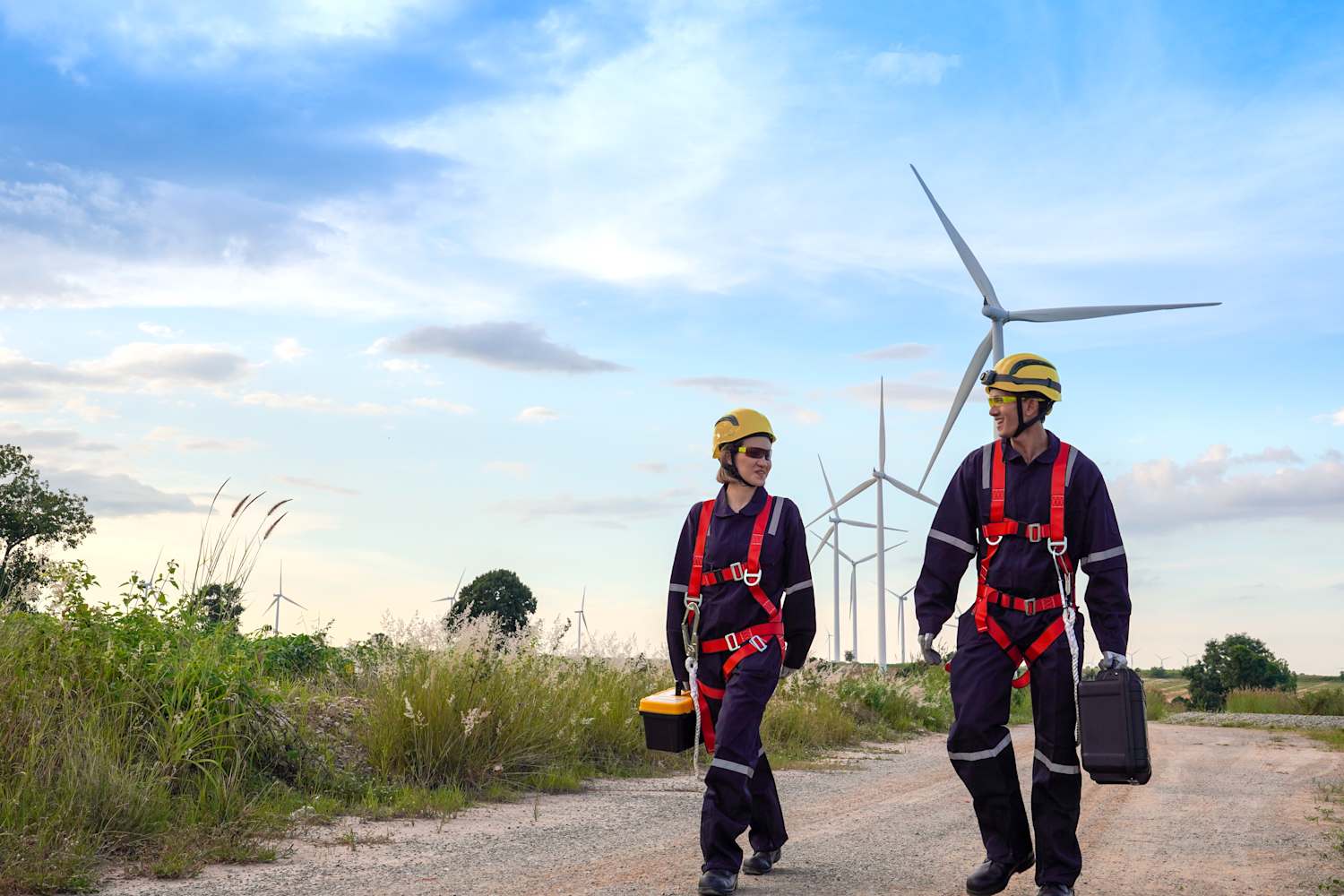How To Become a Wind Turbine Technician
Does renewable energy interest you? UTI can help you train for a career in the field. Learn how to become a wind turbine technician by reading our post!
Key Points
Ever driven past a wind farm and wondered, “How do wind turbines work and what do they do?”
The simple answer is – they help power electrical grids via renewable energy. If you’re intrigued by these towering turbines, keep reading.
In this guide, we’ll dive deeper into what a wind turbine is, how it works, different types of wind turbines and how you can train for a career working on them!

A wind turbine converts wind into electricity. The wind propels the turbine blades to rotate, and this rotation then spins the turbine's generator, which generates electricity.
When the wind blows, it turns the turbine's propeller-like blades around a rotor, which is connected to a main shaft. This shaft then spins a generator to create electricity. The electricity produced by each turbine in the farm is collected into the electrical grid and distributed for use in buildings that need power.

The working of a wind turbine relies on four main components:
Wind turbines are typically found on wind farms, where many wind turbines feed electric power into an electric power grid. Energy from wind can then be used to fuel homes, large buildings and even entire zip codes.
Wind farms are strategically placed in areas with ideal wind speeds and consistency, such as open plains, hilltops or offshore in open water, depending on the energy needs. Learn more about the different types below.
Land-based wind turbines are typically used to generate large amounts of commercial electricity. These turbines are installed on structures built over open land, such as farmer's fields or hillsides, and take a lot of space to set up. Wind-generated electricity then travels through the electrical grid to power nearby homes and businesses.

Offshore wind turbines operate in the same way as onshore wind turbines but are located in bodies of water such as oceans. They have larger rotors than their land-based counterparts to fully use the relatively higher speed of the wind over water, making them more powerful electricity producers. Because of their remote location and high operational capacity, offshore wind farms are also more expensive to build and require specialized installation equipment.
Distributed wind turbines generate electricity on a smaller scale and are frequently located near the end user's home or business, eliminating or reducing the need for transmission lines and their associated costs. These turbines are especially useful in remote areas with otherwise limited or nonexistent access to electricity.
Wind turbines come in various shapes and sizes, each tailored for specific environments and energy needs. This diversity allows for wind energy to be harnessed in a range of locations—from vast plains to offshore expanses. Let’s explore the different types of wind turbines, as well as their unique features and applications:
Wind turbine technicians are responsible for the efficient and safe operation of wind turbines. They often perform inspections, troubleshoot technical issues, perform repairs and maintenance, monitor performance metrics and install new equipment or upgrade existing systems.
These technicians must also effectively communicate the technicalities of any relevant project updates to customers and teammates. This way, everyone involved in the success of these projects knows exactly what is required and whether any issues will impact their progress.
Wind turbine technicians must use math and science reasoning skills to decipher technical diagrams. They must be able to effectively solve problems, which can help them diagnose and repair system errors.
Because they work with intricate machinery, wind technicians must also be well-versed in their industry's technology and have up-to-date computer skills. Effective communication is also essential, whether they’re providing detailed technical instructions to teammates or speaking to customers regarding the service being performed.
Technicians operating on wind turbines must use tools and hoist heavy pieces of equipment onto turbines. Doing so is much easier with manual dexterity and physical strength. Last but certainly not least, technicians must have enough technical knowledge and aptitude to perform their responsibilities correctly.
Technical training and a solid understanding of safety protocols can help wind turbine techs complete their tasks successfully. Technical training consists of wind turbine technician courses that teach the skills needed to diagnose malfunctions in wind turbine systems, troubleshoot issues and understand electrical diagrams.

This type of training is available through UTI’s 30-week Wind Turbine Technician program! Students at our campuses get hands-on training with wind technology in controlled classroom and lab settings.
Our curriculum can help students build a technical foundation that will allow them to pursue entry-level career opportunities in the wind technology industry after graduation.1Graduates can even reach out to UTI's Career Services team to learn more about industry job opportunities and get assistance with their applications!
Wind turbine technicians typically work outdoors, increasing their exposure to severe weather whenever it occurs. They often have to maneuver up tall towers or through tight spaces inside large turbines and could be expected to repair blades or machinery while hundreds of feet above the ground.
Employers may require wind turbine technicians to permanently relocate to the worksite, which could be situated in remote and isolated areas. They must also work with potentially hazardous materials, so a fundamental understanding of safety protocols is critical. Certain employers may also require wind technician safety credentials from their employees to ensure that the worksite complies with local safety regulations.
Fortunately, they frequently work in groups. So, if you get an entry-level wind turbine technician job, you could be surrounded by teammates who have your back. To make the most of this camaraderie, communication and teamwork skills are required!
Read: What Is a Field Service Technician?
With renewable energy at the forefront of power generation, wind power could be a great career to pursue. According to the Bureau of Labor Statistics (BLS), wind turbine service technician is one of the fastest-growing occupations in the U.S.! But, what about salary?
The BLS reported the median annual salary for wind power technicians in the United States was $61,770 in May 2023.61 This means half earned more and half earned less. Keep in mind that salary depends on several factors, including experience, employer, demand and cost of living in the area.
Most of our grads start out working as entry-level technicians or in other entry-level roles. As with any industry, over time, they may be able to advance in their careers with experience and hard work.77 Some entry-level and advanced careers for our wind technician graduates could include:
Entry level:
Advanced:
Read: How To Become a Wind Turbine Technician
A wind turbine’s energy production depends on its size and the speed of the wind passing through its blades. On average, a typical commercial wind turbine with a capacity of 2.5-3 MW can produce around 6 to 9 million kWh of electricity per year.
Wind turbine technicians install, maintain and repair wind turbines. They play a crucial role in ensuring the efficiency and reliability of wind power generation, often working at great heights to complete their duties.
Texas holds the title for the U.S. state with the most wind turbines, leading the nation in wind energy production. This vast state harnesses the power of its extensive plains and hill country to generate a significant portion of its electricity from wind.
Wind turbines do not have engines; instead, they use blades to capture wind energy, which turns a rotor connected to a generator that produces electricity.
A wind generator works by converting kinetic energy from the wind into mechanical energy through rotating blades, which then drives a generator to produce electrical energy.
Wind turbines are powerful producers of electricity that use a renewable source of energy, so it's no surprise that aspiring technicians like you want to be a part of their advancement!
Still wondering, “How do wind turbines work?” Our Wind Turbine Technician training program can answer this crucial question and teach you the technical skills required to pursue a career in wind turbine technology.1 From power generation to installation, maintenance and repair, you can learn how to successfully service wind turbines!
Want to learn more? Request more information about wind turbine training today or apply for wind technician training to get started!
Universal Technical Institute of Illinois, Inc. is approved by the Division of Private Business and Vocational Schools of the Illinois Board of Higher Education.